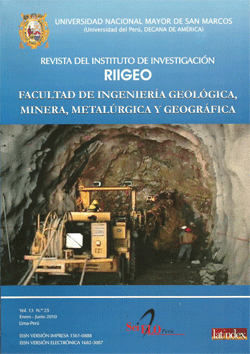Hydrometallurgic treatment of gold disseminated in pyrite and arsenopyrite from flotation tailing
DOI:
https://doi.org/10.15381/iigeo.v13i25.380Keywords:
Oxidation, lixiviation, tailing flotationAbstract
Tailings come from a mineral containing copper, silver and gold and recovery percentages of 90% of copper, 55 % of silver and 10% of gold from flotation. The study and mineralogic characteristic made to tail at 200 x magnification shows the presence of 54% of pyrite and 43% of gangue, does not detect gold, and has a chemical analysis of 3.74 gr/TM gold and 4.18 Oz/TC silver. The cyanidation tests made to the reground tailings at – 45 u give poor recoveries, 10% at most, reinforcing the hypothesis that the precious metal is in solid solution in the pyrite. Based on these results, cyanide lixiviation tests are performed using air and pyrometallurgical oxidation, in the first case 40% of cyanide dissolution is obtained trough air oxidation in alkaline media, and in the second case, 90% of gold is recovered trough roasting tests at 600° C, calcine wash to diminish the consumption of reactives followed by cyanidation by agitation.Downloads
Published
Issue
Section
License
Copyright (c) 2010 Angel Azañero Ortiz, Vidal Aramburú Rojas, Janet Quiñones Lavado, Luis Puente Santibáñez, Manuel Cabrera Sandoval, Victor Falconí Rosadio, Juan de Dios Quispe Valdivia, Oscar Francisco Cardoza Ramos, Kelly Jaimes Mallqui, Alberto Medina

This work is licensed under a Creative Commons Attribution-NonCommercial-ShareAlike 4.0 International License.
AUTHORS RETAIN THEIR RIGHTS:
a. Authors retain their trade mark rights and patent, and also on any process or procedure described in the article.
b. Authors retain their right to share, copy, distribute, perform and publicly communicate their article (eg, to place their article in an institutional repository or publish it in a book), with an acknowledgment of its initial publication in the Rev. Inst. investig. Fac. minas metal cienc. geogr.
c. Authors retain theirs right to make a subsequent publication of their work, to use the article or any part thereof (eg a compilation of his papers, lecture notes, thesis, or a book), always indicating the source of publication (the originator of the work, journal, volume, number and date).






